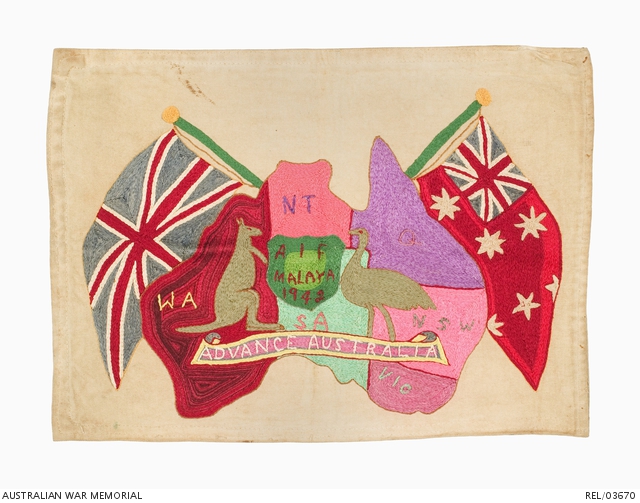| Places | |
|---|---|
| Accession Number | REL/03670 |
| Collection type | Heraldry |
| Object type | Heraldry |
| Physical description | Cotton; Embroidery cotton thread |
| Maker |
Sullivan, Edward Gordon Patrick (Pat) |
| Place made | Burma Thailand Railway, Singapore: Changi |
| Date made | c 1942-1943 |
| Conflict |
Second World War, 1939-1945 |
Embroidered map of Australia : Corporal E G P Sullivan, 2/18 Battalion

Embroidered Commonwealth Bank cotton cash bag. One side is printed with the bank's details. The other is heavily embroidered with mercerised cotton embroidery thread in shades of red, pink, mauve, green, blue, yellow, brown and white. A map of Australia is embroidered in the centre with a Union Jack and Australian red ensign behind it. Both flags are completely filled in with embroidery and are suspended from green flag poles with yellow finials. The red on the Australian flag is shaded. The map of mainland Australia is outlined in brown. Each state is filled with a different colour: Queensland (mauve with a pink 'Q'); New South Wales (pink with a grey 'NSW'); Victoria (plum with a pale green 'VIC'; South Australia (pale green with a pink 'SA'); Northern Territory (Salmon with a mauve 'NT'); and Western Australia (shaded reds with a yellow 'WA'). In the centre is a green shield flanked by an olive green kangaroo and emu. The shield is embroidered in red 'AIF MALAYA 1942'. A red, yellow, blue and plum coloured scroll across the bottom of the map has 'ADVANCE AUSTRALIA' in white. All the embroidery on the bag has been executed in closely spaced lines of stem-stich.
NX55741 Corporal Edward Gordon Patrick 'Pat' Sullivan was born in Deniliquin, NSW, in 1902. He enlisted for service in the Second World War on 1 July 1940 and was assigned to 2/18 Battalion. The battalion sailed to Malaya with the 8th Division of the Australian Imperial Force (AIF) and subsequently took part in the brutal fight against the Japanese before the fall of Singapore in February 1942, when all the survivors were taken prisoner.
Sullivan quickly realised that he would need a hobby to occupy his mind rather than giving way to depression. A friend from 2/9 Field Ambulance gave him a bag of embroidery cottons he had found during the fighting in Singapore. Another prisoner showed him some basic embroidery stitches and helped him with his first attempts at needlework. All the designs on his embroideries were his own work and the Memorial holds several different examples of these in the National Collection. The Commonwealth Bank cash bag came from the paymaster of 2/18 Battalion.
Sullivan intended this bag to be an embroiderer's work bag after he had completed it. Work on the bag took several months to complete. A cushion cover and a tablecloth were the first works to be finished. Sullivan had a single needle which he carried in an improvised bamboo case. His embroidery was done in spare time when he was not required to work by the Japanese, both in Changi and on the Burma-Thailand Railway. A British officer intervened when the Japanese attempted to confiscate one of the embroideries Sullivan was working on, and fellow Australians also helped to conceal his work during other Japanese searches.
Two other brothers of Sullivan were also captured by the Japanese, one surviving and the other dying in June 1945 on Japanese occupied Hainan Island.
Sullivan survived his captivity and returned to Australia. He was discharged on 31 January 1946. Pat is descended from the Aboriginal woman known as 'Black Mary', one of the partners of the infamous Australian bushranger Captain Thunderbolt.